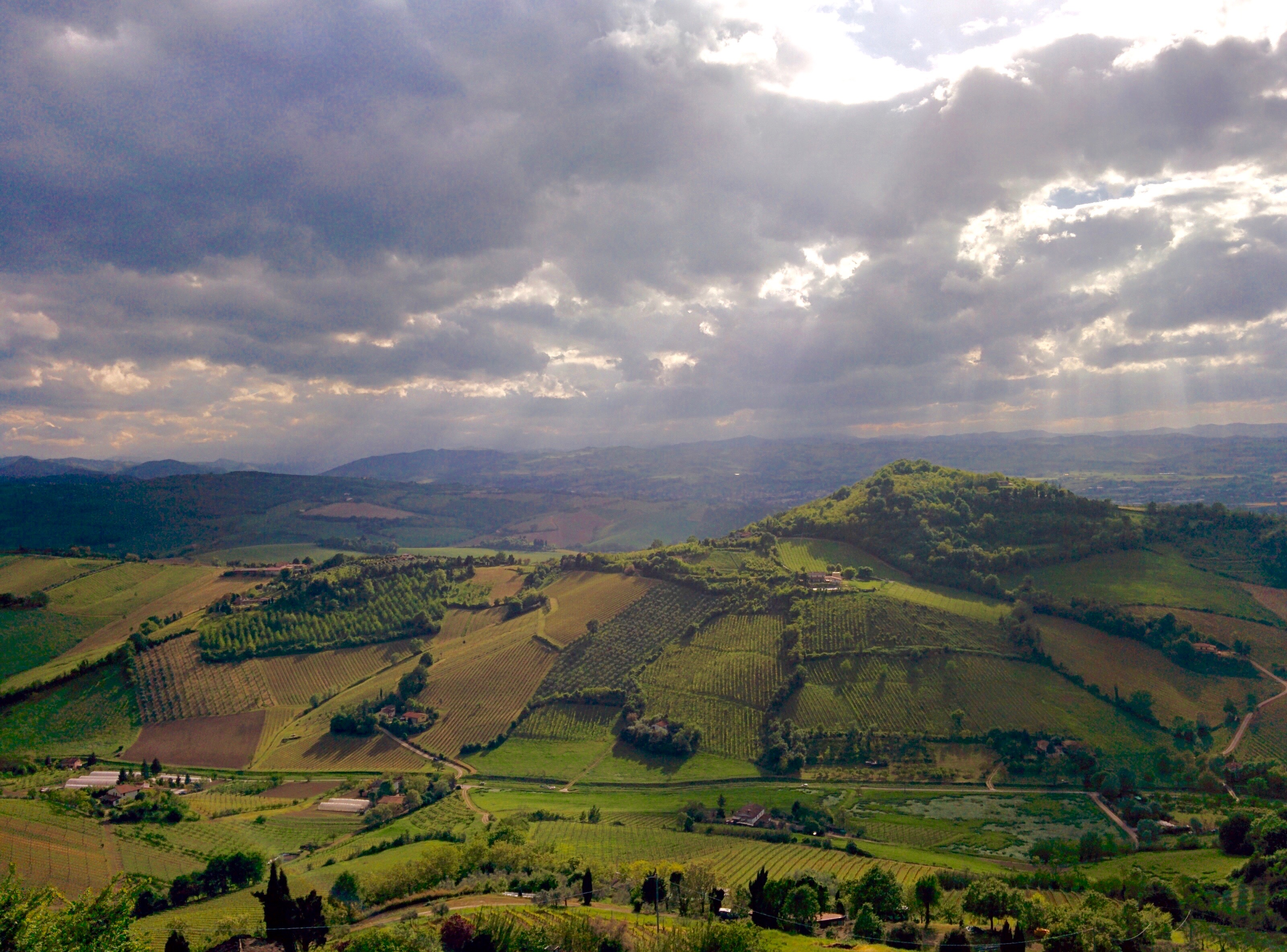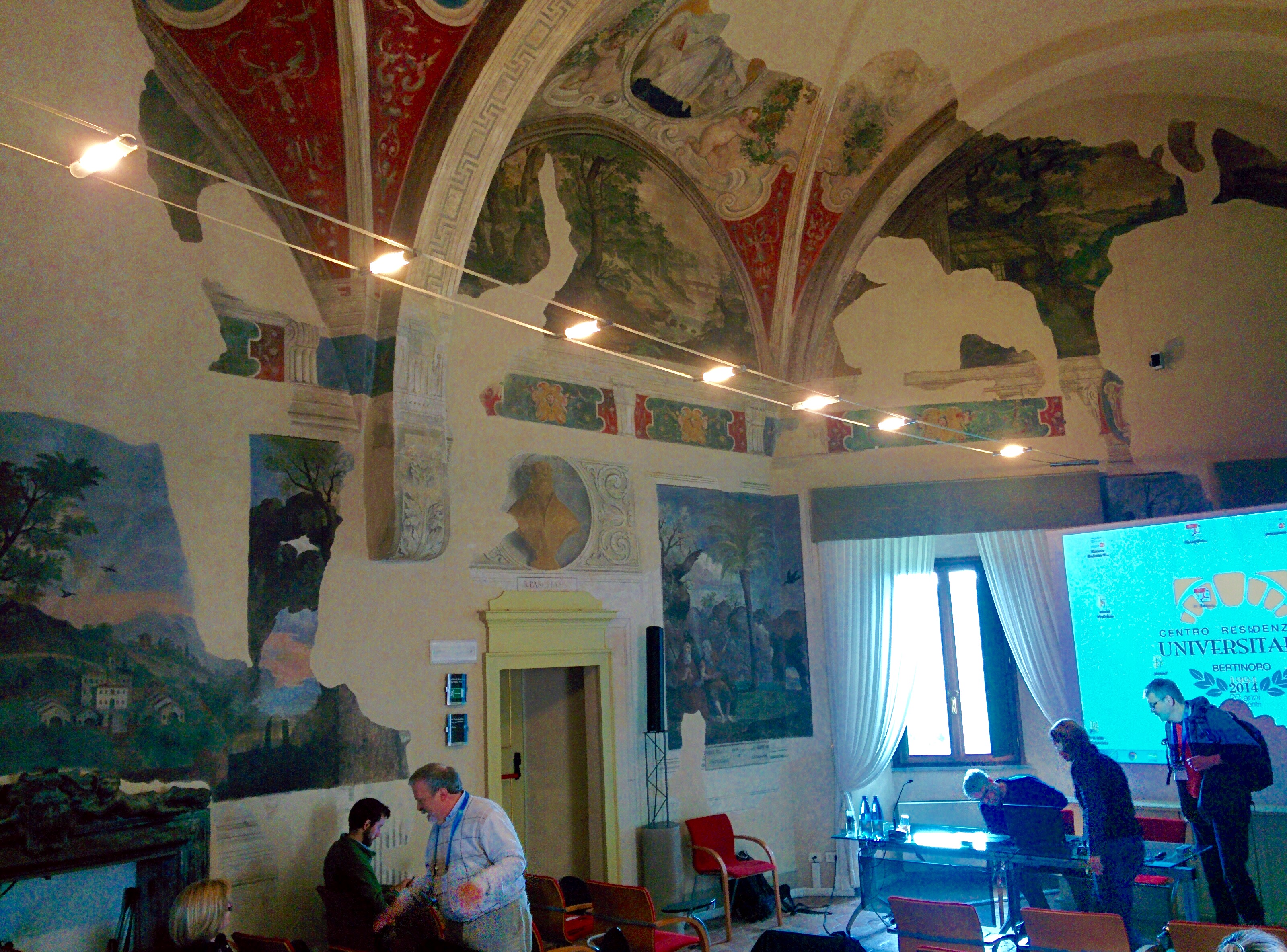Can a single hydrological model structure provide realistic simulations everywhere? Insights from the Bertinoro workshop
Contributed by Nans Addor and Gemma Coxon
View from the conference center on the rolling hills of the Emilia-Romagna region
In April 2016, thirty-one scientists and one mankini-clad Martyn Clark (check here for a recent HEPEX interview with M. Clark) ascended the steep hill on which the italian town of Bertinoro is perched to attend the workshop on ‘Improving the theoretical underpinnings of hydrologic models’.
The overarching aim of the workshop was to launch a new community initiative focused on developing a more structured and theoretically grounded approach to model development and testing (see Clark and co-authors published commentary).
As two of the early career scientists who participated in the workshop, we wanted to share our thoughts and views on what inspired us at the meeting with the wider community. Among the several outstanding questions that were addressed by the participants, three really caught our attention and are directly related to our ongoing research:
- What are existing examples of hydrological theory and how do we develop new hydrological theory?
- How can we reflect the structure of the landscape in the structure of the models?
- How can we develop rigorous approaches to evaluate and select among competing theories and algorithms in the presence of highly uncertain observation data?
After the workshop, the two of us went back to these questions, and revisited them by combining key messages distilled during the workshop together with ideas based on our own experience and research interests. Here we present the results of our post-workshop reflections by focusing on a specific topic: the suitability of hydrological models across varying environments.
Fresco in the main conference room
Our post-workshop reflections
There is a growing number of studies in which a single model structure is applied over large regions and across very diverse hydro-climatic conditions. The HBV model (see also the 2014 Hepex blog post interview with its father, Sten Bergström), for instance, has been run at the global scale (Beck et al, 2016) and models like VIC or mHM are routinely run over continental domains (e.g. Mizukami et al., 2015; Rakovec et al., 2016).
This underscores model flexibility and the considerable progress made recently in estimating parameters over large domains. Consequently, it is now easier than ever to apply a hydrological model everywhere, however, this does not imply model realism. Since model structures have been stretched and run over large regions, attention now needs to be focused on the question, “is the realism of the resulting simulations satisfying”?
In this context, a crucial hypothesis, on which many large-sample modelling experiments and large-scale modelling experiments rest is that: “A single hydrological model structure can provide realistic simulations everywhere”
It is our impression that this hypothesis deserves particular attention and that there are diverging opinions in the community on its validity. In a nutshell, if we can falsify this hypothesis, then parameter flexibility alone is not sufficient, and new methods are necessary to guide model structure choices based on the attributes of the environment. To illustrate this, we approach this hypothesis from the perspective of two presentations held at the workshop by Fabrizio Fenicia and Luis Samaniego. Clearly, this is part of a wider discussion within the hydrological community, but in this post based on the workshop, we are comparing the approaches of two participants. Our aim is to stimulate a dialogue on how to best approach and explore the crucial hypothesis highlighted above.
Two approaches from two presentations
- A significant part of Fabrizio Fenicia’s recent work relies on building and testing modular modelling frameworks. The underlying idea is that the differences between different environments should be represented by different model structures (e.g. Fenicia et al., 2014). An advantage is that relationships between dominant hydrological processes and model structure are explicit, since adequate models are chosen based on the understanding of catchment behaviour, which significantly relies on expert knowledge and field experimentations. This however makes model selection difficult to automatize, especially over large areas, since available datasets do not provide the same support to discriminate between competing hypotheses on hydrological behaviour than personal experience. Furthermore, the use of different models over space makes large-scale modelling difficult.
- In contrast, Luis Samaniego’s recent work based on the multiscale parameter regionalization (MPR, Samaniego et al., 2010) technique and the mHM model builds on the idea that a single model structure can be applied at the continental scale, and adjusted to specific environments by changing its parameter values. Key advantages of this approach is that i) it yields continuous parameter fields with realistic spatial features and ii) it guarantees consistency across spatial scales. Yet the first advantage is a direct result of the use of realistic catchment attribute maps (e.g. soil maps) to produce parameter maps, so in itself is no proof that hydrological processes (e.g. water percolation) are realistically captured. The second advantage is also obtained by construction, this time using the optimization of an objective function to force consistency between water fluxes at different spatial scales (e.g. Rakovec et al., 2016). Nevertheless, we see these two advantages as very likely to contribute to more realistic simulations, and consider them as essential to progress with parameter estimation at the continental scale. Furthermore, MPR opens new opportunities by allowing for the integration of recent (and future) data sets (e.g. FLUXNET and GRACE) to constrain parameter values, and thereby goes beyond traditional approaches based on discharge alone.
We believe it is crucial that both avenues are actively pursued. As long as we can’t falsify the hypothesis that “A single hydrological model structure can provide realistic simulations everywhere”, we still need to develop new methods for parameter estimation, particularly when we need to ensure spatial consistency.
Yet questions still remain over which models are best suited to be applied everywhere and so continued efforts need to be made on testing different model structures across a broad range of environments, and establishing which model processes are missing in current hydrological model structures where we are unable to achieve good model simulations.
To achieve this, we are both involved in research projects in which both approaches are combined, i.e. modular modelling frameworks and novel parameter estimation methods. Our objective is to get a better sense of when it is really necessary to vary the model structure: experience has shown that good (and even realistic) simulations can be achieved by only varying the model parameters, making clear that it is not necessary to have a different model structure everywhere. Yet it is not entirely clear how much a single model structure can be stretched, i.e. in which circumstances it stops providing realistic simulations.
We believe that hydrological modeling experiments in a large number of catchments can provide new insights in this respect and help us to determine how much flexibility should be provided by the model structure and model parameters, respectively.
References
- Beck, H. E., van Dijk, A. I. J. M., Roo, A. de, Miralles, D. G., McVicar, T. R., Schellekens, J. and Bruijnzeel, L. A.: Global-scale regionalization of hydrologic model parameters, Water Resour. Res., 52(5), 3599–3622, doi:10.1002/2015WR018247, 2016.
- Clark, M. P., Schaefli, B., Schymanski, S. J., Samaniego, L., Luce, C. H., Jackson, B. M., Freer, J. E., Arnold, J. R., Moore, R. D., Istanbulluoglu, E. and Ceola, S.: Improving the theoretical underpinnings of process-based hydrologic models, Water Resour. Res., 52(3), 2350–2365, doi:10.1002/2015WR017910, 2016.
- Fenicia, F., Kavetski, D., Savenije, H. H. G., Clark, M. P., Schoups, G., Pfister, L. and Freer, J.: Catchment properties, function, and conceptual model representation: is there a correspondence?, Hydrol. Process., 28(4), 2451–2467, doi:10.1002/hyp.9726, 2014.
- Mizukami, N., Clark, M. P., Gutmann, E. D., Mendoza, P. A., Newman, A. J., Nijssen, B., Livneh, B., Hay, L. E., Arnold, J. R. and Brekke, L. D.: Implications of the Methodological Choices for Hydrologic Portrayals of Climate Change over the Contiguous United States: Statistically Downscaled Forcing Data and Hydrologic Models, J. Hydrometeorol., 17, 73–98, doi:10.1175/JHM-D-14-0187.1, 2015.
- Rakovec, O., Kumar, R., Mai, J., Cuntz, M., Thober, S., Zink, M., Attinger, S., Schäfer, D., Schrön, M. and Samaniego, L.: Multiscale and Multivariate Evaluation of Water Fluxes and States over European River Basins, J. Hydrometeorol., 17, 287–307, doi:10.1175/JHM-D-15-0054.1, 2016.
- Samaniego, L., Kumar, R. and Attinger, S.: Multiscale parameter regionalization of a grid-based hydrologic model at the mesoscale, Water Resour. Res., 46(5), doi:10.1029/2008WR007327, 2010.
Other HEPEX blog posts on hydrological models can be seen here.


October 5, 2016 at 13:11
Maybe we are still holding the perspective that static information as soil type, land cover and terrain is enough to predict the watershed response once we provide meteorological data. In my opinion there is a lack of dynamic information, as soil moisture profile in a fine spatial resolution, to understand better how the heterogeneity of inputs and state variables works to produce the catchment response.